| Robot Minds |
|
||||||||||||||||||||||||
|
Stiquito Kit BattleKits Robot Toys Solar Kits Robot Arms Robosapien Basic Stamp Kits Lego MindStorms
Hobby Robots Robot Sports Electronics Mechanics Robot Minds Books for Kids Robots at Work Microcontrollers Advanced Books Used Books
Robot Motors Remote Controls Robot Parts Robot Tools Magazines Robot Videos Robot News RoboLinks Contact
|
The aspect of robotics that captures the imagination of many enthusiasts
is the possibility of robotic intelligence. In this section we review books that cover
artificial intelligence, fuzzy logic, and other techniques that will someday turn the cold
circuits of a machine into a thinking, self-aware being. Many of these same books
also explore the subjects of ethics, philosophy, science, and great human minds, as well
as robotic minds.
Now, Machines Who Think is back, along with an extended afterword that brings the field up to date in the last quarter century, including its scientific and its public faces. |
||||||||||||||||||||||||
Using an intuitive method, Robot Programming deconstructs robot control into simple and distinct behaviors that are easy to program and debug for inexpensive microcontrollers with little memory. Once you've mastered programming your online 'bot, you can easily adapt your programs for use in physical robots. Robot Programming's hands-on approach to
behavior-based robotics--
Believing that machines with intelligence far beyond that of humans will eventually make the important decisions, Warwick investigates whether we can avoid obsolescence by using technology to improve on our comparatively limited capabilities. Warwick also discusses the implications for human relationships, and his wife's participation in the experiments.
The Age of Spiritual Machines is no list of predictions but a framework for envisioning the 21st century in which one advance or invention leads inexorably to another. After establishing that technology is growing exponentially, Kurzweil forecasts that computers will exceed the memory capacity and computing speed of the human brain by 2020, with the other attributes of human intelligence not far behind. By that time paraplegics will be able to walk by using a combination of nerve stimulation and robotic devices. You will be able to choose the personality of your automated computer assistant, who will conduct business on your behalf with other automated personalities. A mere nine years later, you will be able to enhance your intelligence with neural implants. The upshot is that human identity will be called into question as never before, as a billion years of evolution are superseded in a mere hundred by machine technology that we ourselves have created. We will become cyborgs, but what will computers become?
The impetus to build machines that exhibit lifelike behaviors stretches back centuries, but for the last fifteen years much of this work has been done in Rodney Brooks' laboratory at MIT. His goal is not simply to build machines that are like humans but to alter our perception of the potential capabilities of robots. Our current attitude toward intelligent robots, he asserts, is simply a reflection of our own view of ourselves. In Flesh and Machines : How Robots Will Change Us, Brooks challenges that view by suggesting that human nature can be seen to possess the essential characteristics of a machine. Our instinctive rejection of that idea, he believes, is itself a conditioned response: we have programmed ourselves to believe in our “tribal specialness” as proof of our uniqueness. Brooks, a leading roboticist and computer science professor, believes that robots in the future will probably be nothing like such all-knowing brain machines as 2001's HAL, nor will they resemble the sleek cyborgs of other Hollywood nightmares. Rather, they will be simple, ubiquitous, curious little machines that will have more in common with humans than one might think. Brooks, and his fellow researchers, suggest that the focus of much AI and robot research has been to develop superhuman devices that operate at the highest intellectual levels. Its better, he says, to make a lot of simple, cheap robots that can perform only a few tasks, but do them well. Brooks begins with a brief but comprehensive overview of the field of research into AI and robotics, then dives quickly into his and his fellow enthusiasts' work as they engineer one strange, insect-looking (and weirdly human-acting) metallic creature after another. As sophisticated as current robots are, the real world (especially visual clues) can easily stymie them. Brooks advocates strategies to circumvent such problems--namely, giving up trying to program a model of the world in the robot's memory--in favor of an "out-of-control" approach, in which the robot reacts more naturally with humans. Brooks sees a day not far off when robots become maids, butlers, and lawn mowers, which, combined with remote sensing, will create a demand in robotics that has previously been confined to manufacturing. Similar optimism infuses Brooks' ruminations on machine intelligence; in particular, he addresses our fear that robots could dominate humanity. The world of HAL and Data, of sentient machines, is fast approaching. Indeed, in some ways it has already arrived, as humans incorporate bionic technology and as humanlike machines increasingly take on the work of humans. There's no way of getting around this future and our species will change in the bargain: "With all these trends we will become a merger between flesh and machines." Antitechnologists may shudder at the story line, but readers interested in the gee-whiz possibilities of the digital age will be fascinated by Brooks' vision of what is and what will be.
Following the overview, Murphy contrasts AI and engineering approaches and discusses what she calls the three paradigms of AI robotics: hierarchical, reactive, and hybrid deliberative/reactive. Later chapters explore multiagent scenarios, map making, navigation and path-planning for mobile robots, and the basics of computer vision and range sensing. Each chapter includes objectives, review questions, and exercises. Many chapters contain one or more case studies showing how the concepts were implemented on real robots. Murphy, who is well known for her classroom teaching, conveys the intellectual adventure of mastering complex theoretical and technical material in this excellent introductory text.
The mobile robot systems described in this book were selected from among the best available implementations by leading universities and research laboratories. These are robots that have left the lab and been tested in natural and unknown environments. They perform many different tasks, from giving tours to collecting trash. Many have distinguished themselves (usually with first- or second-place finishes) at various indoor and outdoor mobile robot competitions. Features Dervish, the office-navigating robot, Phoenix, the autonomous underwater vehicle, and many others.
The lead essay, "Can Machines Think?" is a clearly formulated reassessment of current contenders for passing the Turing test, the criterion by which thinking machines are judged. "Speaking for Our Selves" evaluates claims for the legitimacy of multiple personality disorder, and extends the discussion into questioning the notion of selfhood. "Real Patterns," which Dennett calls "utterly central to my thinking," is tougher going, as Dennett addresses an ongoing dispute among philosophers about what it might mean for a belief to be "real," but the essay rewards repeated reading.
|
|||||||||||||||||||||||||
|
Advertise your product on RobotBooks.com Beginners Books |
Hobby Robots |
Robot Sports |
Electronics |
Mechanics |
Robot Minds |
Robot Fiction |
|||||||||||||||||||||||||
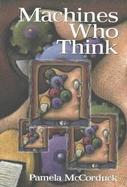 Pamela
McCorduck first went among the artificial intelligentsia when the field was
fresh and new, and asked the scientists engaged in it what they were doing
and why. She saw artificial intelligence as the scientific apotheosis of one
of the most enduring, glorious, often amusing, and sometimes alarming,
traditions of human culture: the endless fascination with artifacts that
think. Machines Who Think was translated into many languages, became an
international cult classic, and stayed in print for nearly twenty years.
Pamela
McCorduck first went among the artificial intelligentsia when the field was
fresh and new, and asked the scientists engaged in it what they were doing
and why. She saw artificial intelligence as the scientific apotheosis of one
of the most enduring, glorious, often amusing, and sometimes alarming,
traditions of human culture: the endless fascination with artifacts that
think. Machines Who Think was translated into many languages, became an
international cult classic, and stayed in print for nearly twenty years.  Growing
Up with Lucy is Steve Grand's first-hand account of the three years
spent trying to build the most advanced artificial intelligence robot in the
world. Steve Grand is a scientist who has deliberately eschewed large public
grants and laboratory affiliation so as to give him the freedom required to put
his revolutionary theories on artificial intelligence to the test. The
result is Lucy, one of the most advanced research robots in existence, and
it is Lucy's successes and failures which stand as indicators of the present
state of robotics.
Growing
Up with Lucy is Steve Grand's first-hand account of the three years
spent trying to build the most advanced artificial intelligence robot in the
world. Steve Grand is a scientist who has deliberately eschewed large public
grants and laboratory affiliation so as to give him the freedom required to put
his revolutionary theories on artificial intelligence to the test. The
result is Lucy, one of the most advanced research robots in existence, and
it is Lucy's successes and failures which stand as indicators of the present
state of robotics.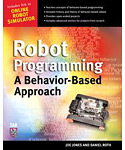 This ingenious
book/Web site partnership teaches the skills you need to program a robot --
and gives you a virtual robot waiting online to perform your commands and
test your programming expertise. You don't need to know either robotics or
programming to get started!
This ingenious
book/Web site partnership teaches the skills you need to program a robot --
and gives you a virtual robot waiting online to perform your commands and
test your programming expertise. You don't need to know either robotics or
programming to get started!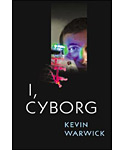 I,
Cyborg is the story of Kevin Warwick, the cybernetic pioneer advancing
science by upgrading his own body. Warwick, the world's leading expert in
cybernetics, explains how he has deliberately crossed over a perilous
threshold to take the first practical steps toward becoming a cyborg - part
human, part machine - using himself as a guinea pig and undergoing surgery
to receive technological implants connected to his central nervous system.
I,
Cyborg is the story of Kevin Warwick, the cybernetic pioneer advancing
science by upgrading his own body. Warwick, the world's leading expert in
cybernetics, explains how he has deliberately crossed over a perilous
threshold to take the first practical steps toward becoming a cyborg - part
human, part machine - using himself as a guinea pig and undergoing surgery
to receive technological implants connected to his central nervous system.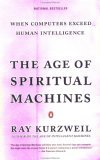 Ray Kurzweil, called a "restless genius" by
The Wall Street Journal, is responsible for some of the most compelling technology of our
era. He is the brains behind the Kurzweil Reading Machine (which helps Stevie Wonder read
his mail), the Kurzweil synthesizer, and the voice-recognition program used in Windows 98.
He is also a formidable thinker who a decade ago predicted the emergence of the World Wide
Web and that a computer would beat the world chess champion. Finally, someone with the
authority to speak about the future also has the courage and imagination to do so.
Ray Kurzweil, called a "restless genius" by
The Wall Street Journal, is responsible for some of the most compelling technology of our
era. He is the brains behind the Kurzweil Reading Machine (which helps Stevie Wonder read
his mail), the Kurzweil synthesizer, and the voice-recognition program used in Windows 98.
He is also a formidable thinker who a decade ago predicted the emergence of the World Wide
Web and that a computer would beat the world chess champion. Finally, someone with the
authority to speak about the future also has the courage and imagination to do so. 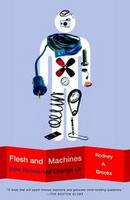 Flesh and Machines explores the startlingly reciprocal connection
between humans and their technological brethren, and explains how this relationship is
being redefined as humans develop increasingly complex machines.
Flesh and Machines explores the startlingly reciprocal connection
between humans and their technological brethren, and explains how this relationship is
being redefined as humans develop increasingly complex machines. Author Valentino Braitenberg documents an elegant thought
experiment exploring how complex behaviors can arise from the simplest mechanisms. He
starts his theoretical explorations with a robot consisting of one simple sensor tied to a
single wheel. He expands the complexity of this machine with multiple sensors, two wheels,
cross-wired sensors, inhibitors and switches, and eventually creates a robot that is not
necessarily intelligent, but which behaves intelligently. Thought experiments
with anthropomorphic titles such as love, fear, and aggression are tied to increasingly
complex behaviors. You'll enjoy these "little toys of the mind".
Author Valentino Braitenberg documents an elegant thought
experiment exploring how complex behaviors can arise from the simplest mechanisms. He
starts his theoretical explorations with a robot consisting of one simple sensor tied to a
single wheel. He expands the complexity of this machine with multiple sensors, two wheels,
cross-wired sensors, inhibitors and switches, and eventually creates a robot that is not
necessarily intelligent, but which behaves intelligently. Thought experiments
with anthropomorphic titles such as love, fear, and aggression are tied to increasingly
complex behaviors. You'll enjoy these "little toys of the mind".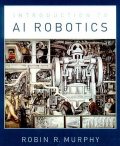 Introduction to AI Robotics covers all the material needed
to understand the principles behind the AI approach to robotics and to program an
artificially intelligent robot for sensing, navigation, planning, and uncertainty. Robin
Murphy is extremely effective at combining theoretical and practical rigor with a light
narrative touch. In the overview, for example, she touches upon anthropomorphic robots
from classic films and science fiction stories before delving into the nuts and bolts of
organizing intelligence in robots.
Introduction to AI Robotics covers all the material needed
to understand the principles behind the AI approach to robotics and to program an
artificially intelligent robot for sensing, navigation, planning, and uncertainty. Robin
Murphy is extremely effective at combining theoretical and practical rigor with a light
narrative touch. In the overview, for example, she touches upon anthropomorphic robots
from classic films and science fiction stories before delving into the nuts and bolts of
organizing intelligence in robots. This is a collection of thirteen case studies of autonomous mobile robots
from leading researchers and universities. Artificial Intelligence and Mobile
Robots is divided into three parts--mapping and navigation, vision, and mobile robot
architectures.
This is a collection of thirteen case studies of autonomous mobile robots
from leading researchers and universities. Artificial Intelligence and Mobile
Robots is divided into three parts--mapping and navigation, vision, and mobile robot
architectures. Minds are complex artifacts, partly biological and partly social. How did they
arise, and how do they work? Only a theory that draws together scientific work from
several fields will give us realistic answers to these questions. One of the movers and
shakers in the rapidly converging fields of cognitive science, philosophy of the mind, and
cognitive ethnology, Daniel C. Dennett is also one of the most popular and engaging
science writers of the 1990s. Brainchildren assembles Dennett's essays on the
philosophy of mind, artificial intelligence, and animal cognition that appeared in
specialized journals from 1984 to 1996.
Minds are complex artifacts, partly biological and partly social. How did they
arise, and how do they work? Only a theory that draws together scientific work from
several fields will give us realistic answers to these questions. One of the movers and
shakers in the rapidly converging fields of cognitive science, philosophy of the mind, and
cognitive ethnology, Daniel C. Dennett is also one of the most popular and engaging
science writers of the 1990s. Brainchildren assembles Dennett's essays on the
philosophy of mind, artificial intelligence, and animal cognition that appeared in
specialized journals from 1984 to 1996.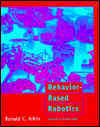 This introduction to the principles,
design, and practice of intelligent behavior-based autonomous robotic systems is the first
true survey of this robotics field. The author presents the tools and techniques central
to the development of these systems in a clear and thorough manner. Following a discussion
of the relevant biological and psychological models of behavior, he covers the use of
knowledge and learning in autonomous robots, behavior-based and hybrid robot
architectures, modular perception, robot colonies, and future trends in robot
intelligence.
This introduction to the principles,
design, and practice of intelligent behavior-based autonomous robotic systems is the first
true survey of this robotics field. The author presents the tools and techniques central
to the development of these systems in a clear and thorough manner. Following a discussion
of the relevant biological and psychological models of behavior, he covers the use of
knowledge and learning in autonomous robots, behavior-based and hybrid robot
architectures, modular perception, robot colonies, and future trends in robot
intelligence.